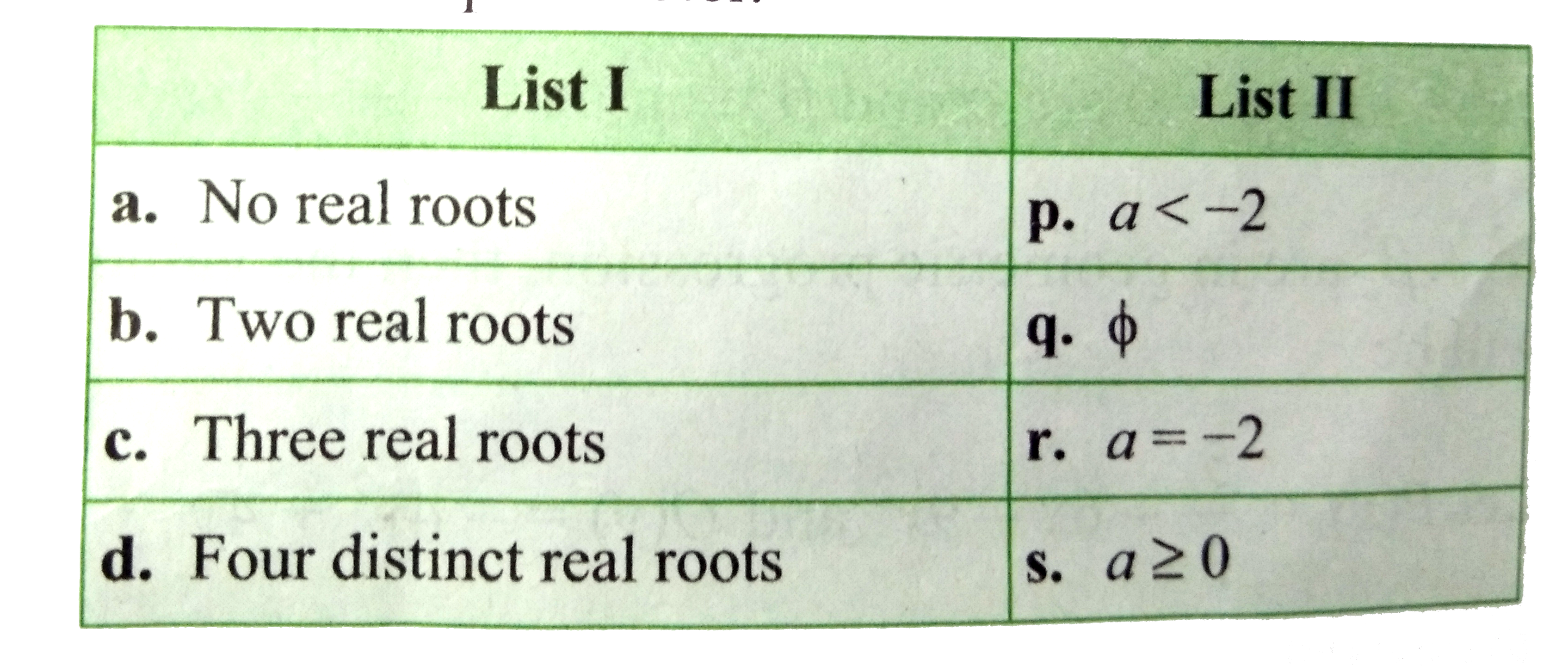If the equation whose roots are the squares of the roots of the cubic x3−ax2+bx−1=0 is identical with the given cubic equation, then (A) a=0,b=3 (B) a=b=0 (C) a=b=3 (D) a,b, are roots ofx2+x+2=0Solution in Bengali
a=0,b=3
a = b = 0
a = b = 3
a, b are roots of x2+x+2=0
The correct Answer is:2,3,4
Given equation is x3−ax3+bx−1=0 . If roots of the equationo
be α,β,γ, then
α2+β2+γ2=(α+β+γ)2−2(αβ+βγ+γα)
=α2−2a
α2β2+β2γ2+γ2α2=(αβ+βγ+γα)2−2αβγ(α+β+γ)
b2−2a
α2β2γ2=1
So, the equations whose roots are α2,β2,γ2 is given by
x3−ax2+bx−1=0
⇒a2−2b=aandb2−2a=b
Eliminatng b, we get
(a2−a)24−2a=a2−a2
or a{a(a−1)2−8−2a(a−1)}=0
or a(a3−2a2+a+2)=0
or a(a−3)(a2+a+2)=0
⇒a=0ora=3ora2+a+2=0
Which gives b = 0 or b = 3 b2+b+2=0.So a = b - 0 or
a = b =3 or a a, b are roots of x2+x+2=0
Topper's Solved these Questions
- BOOK - CENGAGE PUBLICATIONCHAPTER - THEORY OF EQUATIONSEXERCISE - Linked Comprechension Type37videos
THEORY OF EQUATIONS
- BOOK - CENGAGE PUBLICATIONCHAPTER - THEORY OF EQUATIONSEXERCISE - MATRIX MATCH TYPE6videos
THEORY OF EQUATIONS
- BOOK - CENGAGE PUBLICATIONCHAPTER - THEORY OF EQUATIONSEXERCISE - Single Correct Answer Type : Exercise89videos
THEORY OF EQUATIONS
- BOOK - CENGAGE PUBLICATIONCHAPTER - STRAIGHT LINESEXERCISE - ARCHIVES (NUMERICAL VALUE TYPE)1videos
STRAIGHT LINES
- BOOK - CENGAGE PUBLICATIONCHAPTER - THREE DIMENSIONAL GEOMETRYEXERCISE - All Questions291videos
THREE DIMENSIONAL GEOMETRY
Similar Questions
Consider an unknow polynomial which divided by (x−3) and (x−4) leaves remainder 2 and 1, respectively. Let R(x) be the remainder when this polynomial is divided by (x−3)(x−4).
If equations R(x)=x2+ax+1 has two distint real roots, then exhaustive values of a are.07:26View SolutionMatch the following for the equation x2+a|x|+1=0 where, a is a parameter.
 01:39View Solution
01:39View SolutionThe value of expression x4−8x3+18x2−8x+2 when x=2+√3
01:25View SolutionFor a point P in the plane, let d1(P)andd2(P) be the distances of the point P from the lines x−y=0andx+y=0 respectively. The area of the region R consisting of all points P lying in the first quadrant of the plane and satisfying 2≤d1(P)+d2(P)≤4, is
03:57View SolutionFind the angle between the line whose direction cosines are given by l+m+n=0andl2+m2−n2=0.
02:38View SolutionIf the equation whose roots are the squares of the roots of the cubic x3−ax2+bx−1=0 is identical with the given cubic equation, then a=0,b=3 b. a=b=0 c. a=b=3 d. a,b, are roots ofx2+x+2=0
07:50View SolutionIf the equation x2−bx+1=0 does not possess real roots, then −3<b<3 (b) −2<b<2 (c) b>2 (d) b<−2
02:13View SolutionIf a and b are roots of the equation x2+ax+b=0 , then a+b= (a) 1 (b) 2 (c) −2 (d) −1
05:32View SolutionThe equation whose roots are the squares of the roots of x3+ax+b=0 is
01:27View SolutionIf a,b,c,d∈R−{0} , such that a,b are the roots of equation x2+cx+d=0 and c,d are the roots of equation x2+ax+b=0, then |a|+|b|+|c|+|d| is equal to
01:47View SolutionIf the equation whose roots are the squares of the roots of the cubic x3−ax2+bx−1=0 is identical with the given cubic equation, then (A) a=0,b=3 (B) a=b=0 (C) a=b=3 (D) a,b, are roots ofx2+x+2=0
05:49View SolutionIf the roots of the cubic equation, x3+ax2+bx+c=0 are three consecutive positive integers, then the value of (a2/b+1) is equal to?
01:59View SolutionIf the roots of the equation x2+ax+b=0arecandd, then roots of the equation x2+(2c+a)x+c2+ac+b=0 are a c b. d−c c. 2c d. 0
10:27View SolutionIf x=1 is a common root of the equations ax2+ax+3=0 and x2+x+b=0 , then ab=
05:22View SolutionIf a and b are roots of the equation x2+ax+b=0 , then a+b=
(a) 1 (b) 2 (c) −2 (d) −107:46View SolutionIf the ratio of the roots of the equation a x2+bx+c=0 is equal to the ratio of the roots of the equation x2+x+1=0, then a, b , c are in
05:34View Solution

